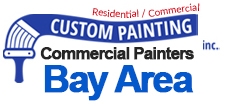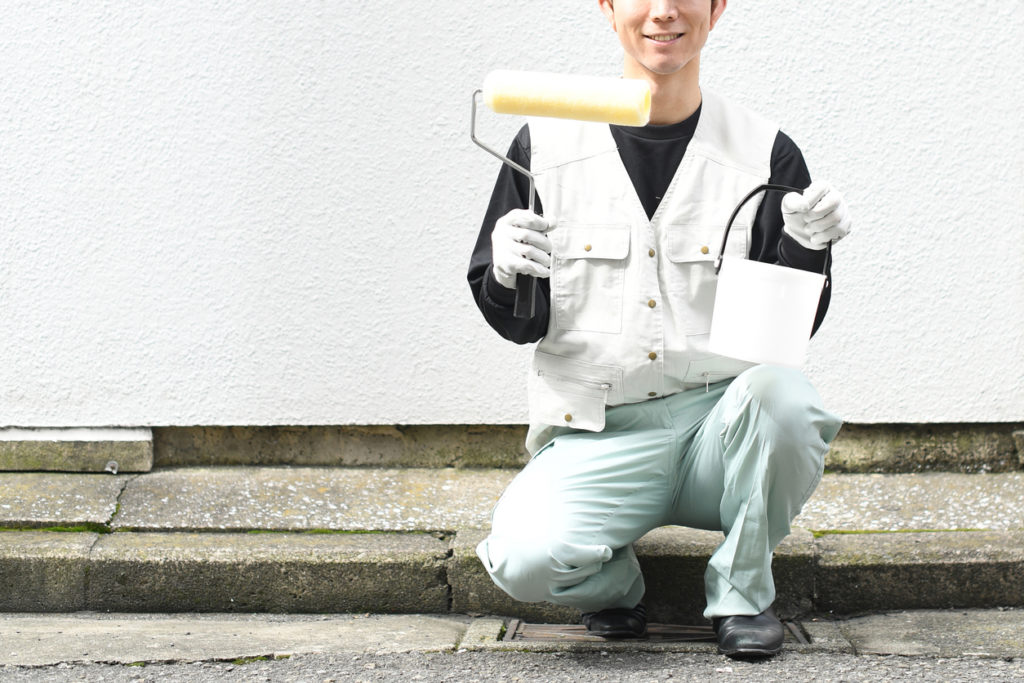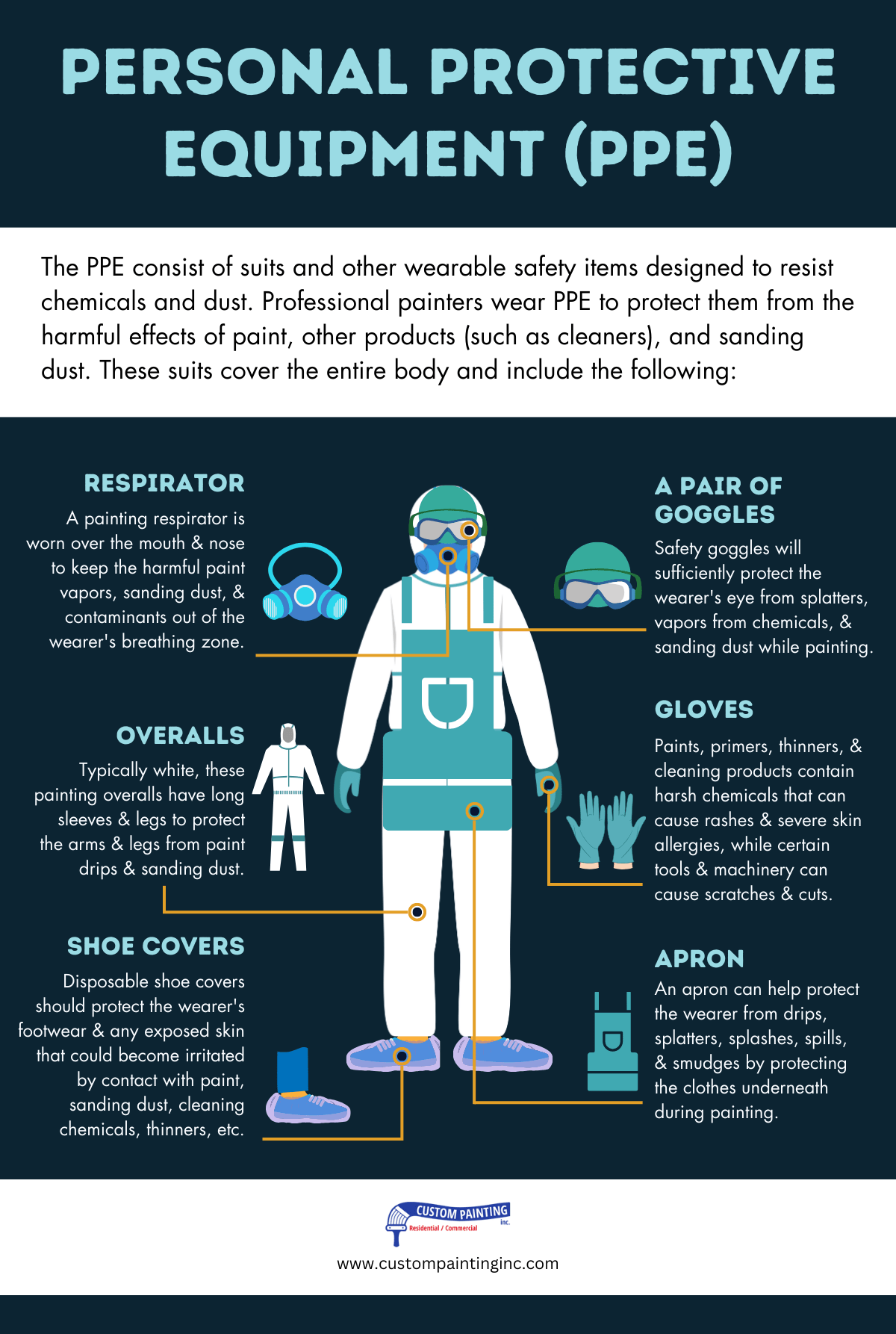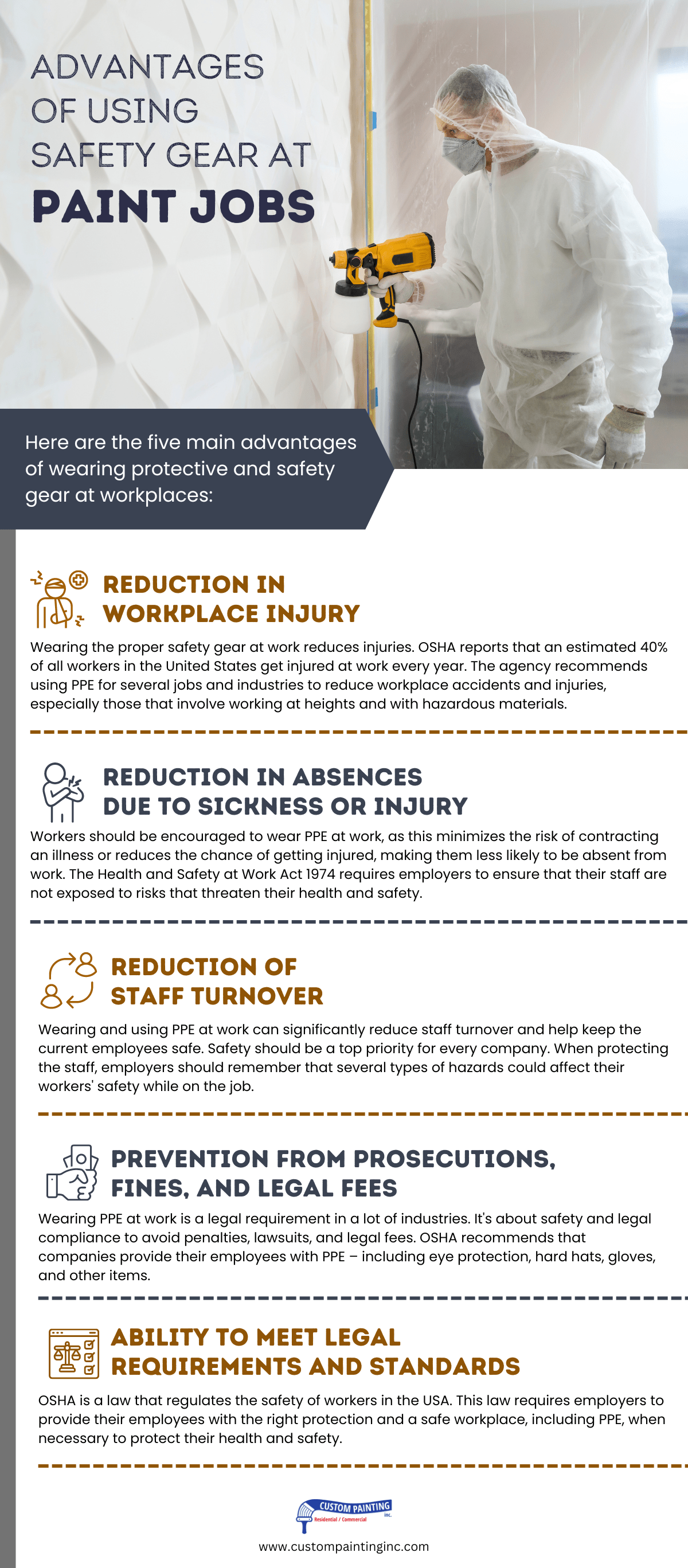Suppose you think that commercial painters in Dublin protect themselves with an ordinary face mask and a cap. In that case, there’s so much you need to learn about the different types of equipment that painters use to protect themselves from various hazards.
Safety gear is essential not only as protection for the painters but also as protection from legal repercussions for the company for which they work.
As you can see, workplace safety is both an employer’s duty and moral responsibility to look after its employees’ welfare and safety. Providing the workers with safety gear is not an option but a requirement. Any responsible paint service company always ensures that its paint crew wears the proper safety gear when they’re at the work site.
Understanding the risks in paint jobs
One may think painting is an easy way to refresh and update a space. It is true that painting is less labor-intensive and more cost-effective compared to remodeling, but it doesn’t mean it’s a totally risk-free endeavor.
The truth about painting is that one may get seriously sick or injured if the right precautions are not taken.
Prolonged standing, slips and falls, working at heights, exposure to chemicals and sanding dust, working in confined spaces, improper ventilation, exposure to extreme temperatures, electrical hazards, repetitive strain injury, injury from using certain tools and equipment, and high-frequency noise are some of the common hazards in residential and commercial painting.
Who is responsible for providing protective gear for the crew?
Whether it is commercial painting or any other profession and the activity of the professional, their PPE should be the responsibility of their employer. This is also mentioned in article R. 4321-4 of the Labor Code, which requires the employer to provide their crew with free PPE and ensure that they function and are maintained properly.
Suppose the employers fail or neglect to provide their crew with the proper PPE. In that case, the workers should claim compensation if they suffer from injury from an accident or illness due to exposure to a hazardous material without wearing any safety gear. The workers may also demand compensation from their employers if the latter fail or neglect to provide them with proper working conditions, such as adequate ventilation or air conditioning, which is essential in driving away toxic paint fumes.
In addition, the employees may suffer from professional implications if they aren’t given proper safety equipment, and protection can also lead to professional implications. Occupational Safety and Health Administration (OSHA) estimates that 40% of all employees in the US suffer from injury at work every year. Non-compliance with health and safety regulations can lead to a greater increase in workplace injury and, in turn, frequent absences and staff turnover.
Besides professional implications, not complying with occupational health and safety regulations can result in adverse legal consequences on the part of the employer.
OSHA regulates American workers’ health and safety. The agency requires employers to provide their workers with a safe workplace and the right protection from several hazards. OSHA states that employers must provide their employees with PPE when there is a risk or danger to their health and safety while at work.
Personal protective equipment (PPE)
Why do commercial painters need to use PPE? Here are a few reasons:
- Traditional paints and other supplies usually contain harsh chemicals. Unprotected exposure to paint fumes frequently or for a long time may cause severe health consequences, from dizziness to respiratory problems to certain cancers. The PPE is designed to protect the crew working with paint, primers, varnishes, thinners, wood stains, and other things they may usually deal with, like cleaning products and sanding dust.
- The PPE is designed to protect the crew from injury due to various causes, such as falling from a height, dropped objects, cuts from sharp or rough objects, slips, etc.
The PPE consists of suits and other wearable safety items designed to resist chemicals and dust. The PPE is worn by professional painters to protect them from the harmful effects of paint, other products (such as cleaning products), and sanding dust.
These suits cover the entire body and include the following:
- Overalls – These painting overalls usually have long sleeves, long legs, and a hood to protect the painter from paint drips, splatters, and sanding dust.
- Respirator – A painting respirator should be worn over the mouth and nose to keep paint vapors, sanding dust, and other contaminants out of the wearer’s breathing zone. In addition, it should fit tightly and securely around the wearer’s face so that there’s no chance for the dust and vapors to get through the gaps in the mask.
- Goggles – A proper pair of goggles sufficiently protects the wearer’s eye area from irritation and injury from paint splatters, vapors from chemicals, and sanding dust while painting. Some goggles have tinted lenses to help block the sun’s ultraviolet rays when working outdoors or prevent glare when working indoors.
- Gloves – Paints, primers, thinners, cleaning products, and other supplies contain harsh chemicals that can cause rashes and severe skin allergies. Certain tools and machinery, on the other hand, can cause abrasions and cuts. A pair of quality gloves should be worn on both hands to protect them from those elements. Some gloves are disposable, while others are reusable and can be washed properly after use.
- Apron – An apron protects the wearer from drips, splatters, splashes, spills, and smudges by protecting the clothes underneath during painting.
- Shoe covers – Disposable shoe covers should serve to protect the wearer’s shoes and exposed skin that could become irritated by contact with paint, sanding dust, cleaning chemicals, thinners, etc.
Spray painting is one of the common methods of paint applications, especially in commercial paint projects. Here are the following PPE to protect painters from over-paint mist due to overspray.
- Eye protection is approved by the American National Standards Institute (ANSI), including a shield and/or a pair of goggles (if necessary).
- Respiratory protection is approved by the National Institute for Occupational Safety and Health (NIOSH) and Occupational Safety and Health Administration (OSHA), including the N95 filtering face piece respirator.
- Protective clothing that includes coveralls, long-sleeved shirts, rubber gloves, and footwear.
Safety equipment for painters working at heights
Professional paint jobs often involve working at heights, requiring the use of raised surfaces like step ladders, scaffolding, and mechanical lifts. Depending on the project’s working conditions and environment, it can involve many types of safety equipment.
Some equipment is designed to prevent the painter from falling, while others are designed to protect the painter should a fall occur.
All PPE should be safely constructed and designed, as well as maintained in a clean and reliable manner. It should fit snugly and comfortably, which encourages worker use. If the PPE does not fit properly, it can make a big difference between being adequately protected or dangerously exposed. painter from falling and while others are designed to protect the painter should a fall occur.
As in all painting and construction works and sites, wearing safety gear is a strict requirement. When painting above ground level, any painter should wear the following for protection:
- Personal protective equipment (PPE) – Aside from the list of PPE mentioned earlier in this article, a painter working at heights should also wear the following:
- Hard hat – It protects the wearer’s head in the event of a possible impact caused by a falling object or collision during a fall.
- Harnesses and carabiners – A safety harness refers to a system of restraints that protects the wearer from injurious or fatal falls. The harness is usually attached to a stable and stationary object (such as a railing) and secured by carabiners, which are coupling links with a safety closure. These safety gear items ensure that the wearer will not hit the ground if he slips and falls.
- Safety vest or jacket – Painters working at heights should wear a reflective or visibility safety vest or jacket so that they will be seen and alert that someone is present, particularly in low-visibility situations.
- Lifelines and anchors – Painters working at heights should be tethered to anchors or lifelines to make sure that they can move freely but won’t fall and hit the ground they slip or trip. Lifelines and anchors include fall arrest and fall restraint systems that function as protection for people working at heights in lieu of collective fall protection systems.
- Roof guardrails and safety rails – Roof guardrails and safety rails must be installed to protect the workers from falling off the edge of a balcony, as protective barriers. If there is a point of access to an elevated area, self-closing safety gates should be installed together with the rails.
- Covers and domes – Covers and domes provide protection to the painters who are painting on a roof or any top of the building. They should be installed over or around skylights or roof lights to prevent the workers from falling through them.
Hearing protection equipment
Painters who work near or around high-frequency noise – such as noise coming from vehicles or a heavy-duty machine – are at risk of temporarily or permanently losing their hearing.
OSHA requires employers to provide hearing protectors to all their employees who are exposed to an 8-hour time-weighted average of 85 decibels or greater, free of charge. Hearing protectors shall be replaced as needed.
Workers should be provided by their employers with adequate necessary hearing protection, including high-attenuation earplugs and earmuffs. If the noise levels are high or if a person has very sensitive hearing, earplugs and earmuffs can be worn together.
In addition to noise, some chemicals can also affect any worker’s sense of hearing. Certain chemicals, called ototoxicants, can lead to hearing loss if the workers are exposed to them frequently or for long hours. Industries that use potential ototoxicants include construction, mining, manufacturing, agriculture, utilities, as well as painting.
In painting, ototoxicants can be found in many paints and other coating products, thinners, degreasers, adhesive substances, etc.
To prevent the painters from coming in direct contact with ototoxic chemicals while working with them, they should wear the basic PPE listed earlier: overalls, gloves, goggles, and respirators.
Advantages of using safety gear at paint jobs
Here are the five main advantages of wearing protective and safety gear at workplaces:
1) It reduces incidences of workplace injury
OSHA estimates that 40% of all American workers get injured at work each year. The agency recommends the use of PPE for several jobs and industries to help reduce workplace accidents and injuries, especially for crews involved in working at heights and with hazardous materials.
2) It reduces worker absences
Employers should provide workers with the proper PPE, and workers should be encouraged to wear them at work. This helps in reducing the risk of contracting an illness or getting injured, making them less likely to be absent from work.
3) It reduces staff turnover
Using and wearing proper PPE at work can help significantly reduce staff turnover and help keep the current employees safe.
There are several types of hazards that could affect the workers’ health and safety while on the job. For example, in commercial painting, exposure to paint fumes or working above ground are the common hazards that painters encounter. Wearing PPE is one way that employees can protect their workers from such dangers. Employers must make sure that they provide their workers with the proper PPE.
Wearing PPE can help reduce staff turnover rates in a company, as protecting workers from hazardous conditions with the right safety gear will help keep them safe, healthy, and happy at work.
4) It prevents companies from prosecutions, fines, and legal fees
Wearing PPE at work is a legal requirement in several companies and industries. It’s not just for safety. It’s also a legal compliance to avoid fines, legal fines, and lawsuits.
OSHA recommends that employers should provide their workers with the PPE. On the other hand, employees should also be encouraged to wear PPE, especially when working in hazardous conditions or near heavy equipment. The purpose of the PPE is to help protect the workers against illnesses or injuries that could happen during their jobs.
There are a lot of cases where workers get sick or injured (or worse) on the job because of poor working conditions, defective products, or poorly manufactured equipment. The irony here was that these unfortunate and tragic incidences could have been easily prevented had their employer taken safety precautions.
Here’s an example: if you are a painter and you get injured while wearing PPE at work, it can be difficult to prove that your employer neglected his responsibility in providing you with the proper PPE, which might cause your injury. However, if you are not wearing any safety equipment when you get injured or sick on the job, it becomes much easier for your attorney to argue that your employer did not provide you with the proper PPE for your job.
If it is proven that the employer neglected to provide PPE to their employees, the employer can face serious legal consequences. OSHA may even issue a citation or fines if the employees get sick or injured because they weren’t provided with PPE. To avoid legal and civil penalties, employers should provide their workers with all the PPE they need, particularly if they work in hazardous environments, work with chemicals, or operate heavy machinery.
5) It meets legal requirements and standards
Once again, OSHA regulates and protects the safety of the workers in the USA. Therefore, the agency requires employers to provide their crew with a safe workplace and proper PPE, including providing them with PPE when necessary to protect their health and safety, especially when there is a risk or danger to their health and safety during the job.
In addition to PPE, employers must provide adequate training for employees who use PPE as it helps them understand why they need them and how to use them properly so that they do their job properly. Also, employees must ensure that any PPE supplied is maintained properly so that it will function well if needed during an emergency.
Here are the following instructions that companies should follow in using and maintaining their PPE:
- Always take care of your PPE.
- Make sure to check your PPE before and after each use.
- Always clean and sanitize your PPE for safer use.
- If the PPE is disposable (such as disposable gloves and shoe covers), don’t reuse them; discard them instead.
- Do not share used PPE, as this practice can result in high levels of accidental contamination.
- Repair or replace damaged PPE.
- After using your PPE, store it in a clean and dry place that is free from sunlight, moisture, and contaminants.
Conclusion
In every workplace, safety should be a top priority. Employers must provide their employees with the proper personal protective equipment or PPE and ensure its proper use when in a working environment or work practice. Employers are also required to train each worker to use PPE correctly.
In industries such as painting, commercial painters in Dublin, CA, or other cities in the Bay Area who deal with paint fumes, work at heights, etc., are required and encouraged to wear properly designed and constructed PPE. They should be correctly constructed and designed to protect the workers’ bodies from potential harm.
When the PPE is used correctly and together with established safety procedures, the safety equipment can be quite effective at protecting the best painters in the Bay Area, CA, from injuries, illnesses, or fatalities. A reputable painting contractor always puts safety as a top priority in every project they tackle for a safe and successful paint job.
If commercial painting is planned soon for your business, call Custom Painting, Inc. at 510-795-0903 to discuss your painting needs and questions about our security practices. You can also contact us by completing the Contact form, and someone from the office will get back to you as soon as possible.





